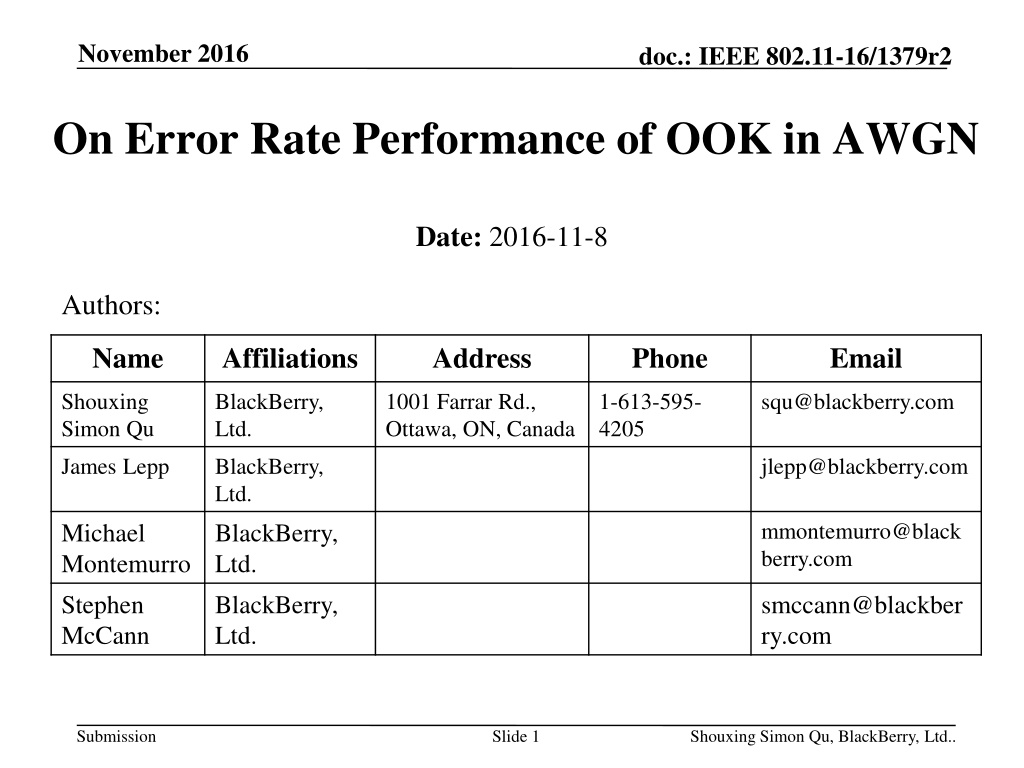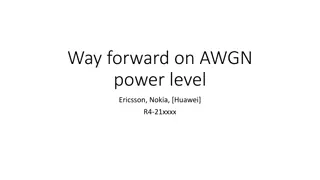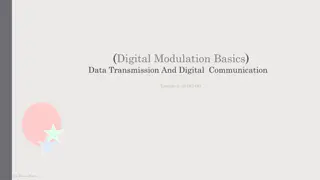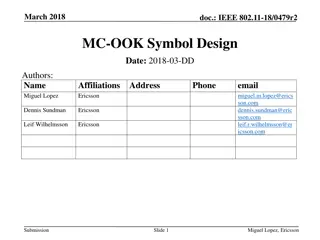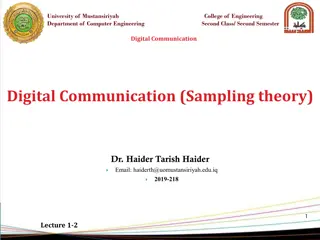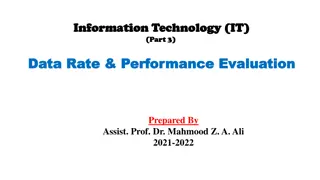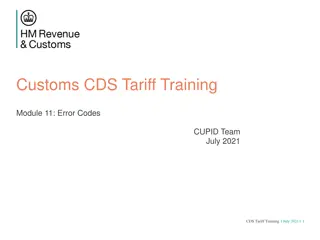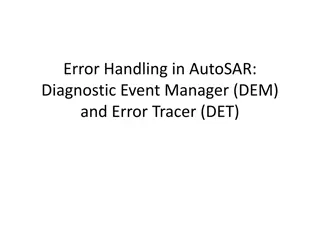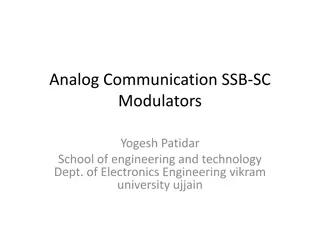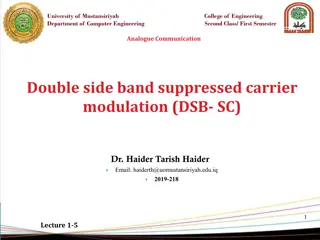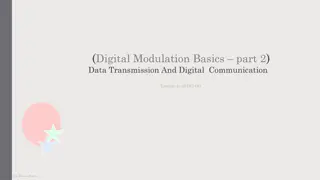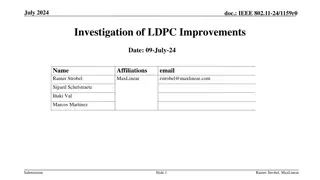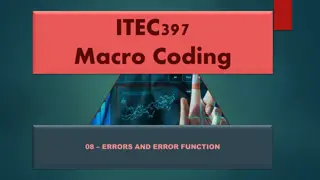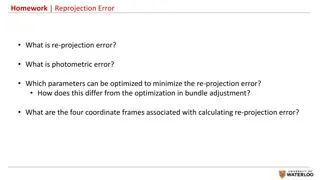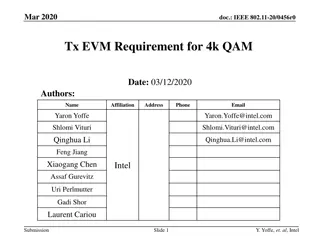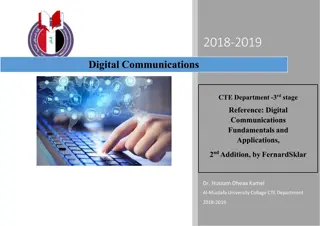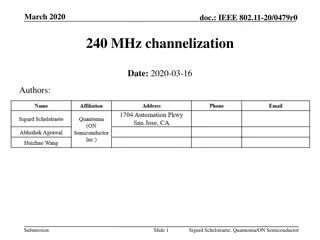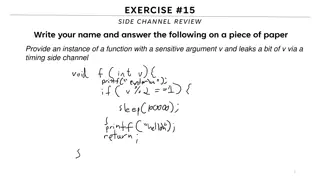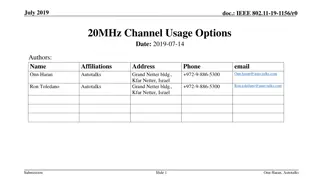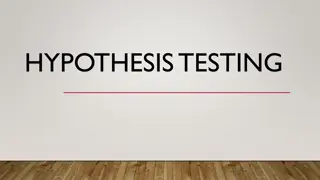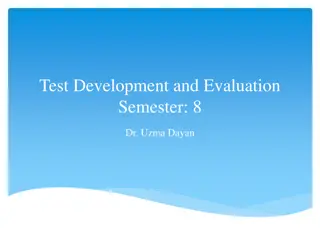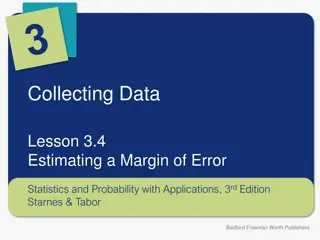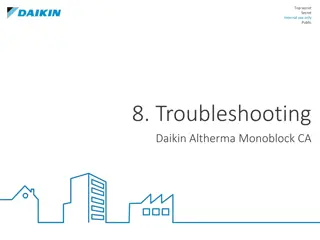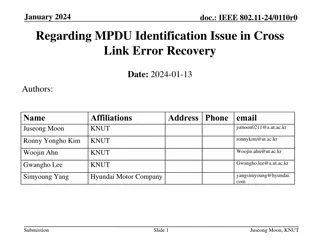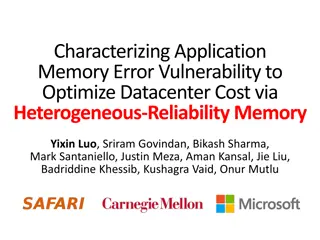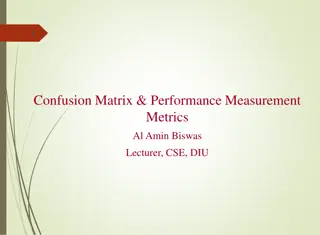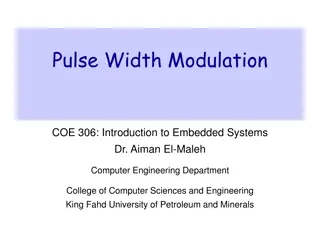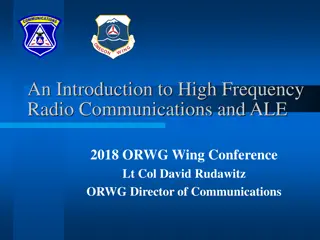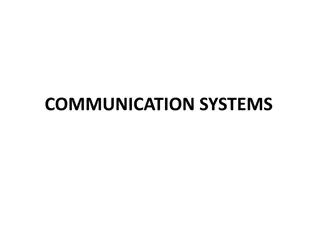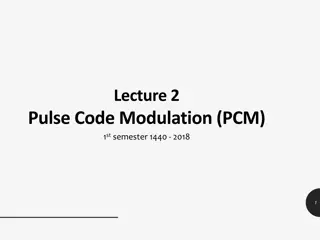Error Rate Performance of OOK Modulation in AWGN Channels
This document discusses the error rate performance of On-off keying (OOK) modulation in Additive White Gaussian Noise (AWGN) channels, covering both coherent and non-coherent detection methods. The theoretical results and evaluations of OOK modulation in AWGN are reviewed, providing insights into optimum threshold issues for non-coherent detection. The technical details include baseband OOK signal characteristics, waveform representations, detection techniques, and performance metrics for both coherent and non-coherent scenarios.
Download Presentation

Please find below an Image/Link to download the presentation.
The content on the website is provided AS IS for your information and personal use only. It may not be sold, licensed, or shared on other websites without obtaining consent from the author. Download presentation by click this link. If you encounter any issues during the download, it is possible that the publisher has removed the file from their server.
E N D
Presentation Transcript
November 2016 doc.: IEEE 802.11-16/1379r2 On Error Rate Performance of OOK in AWGN Date: 2016-11-8 Authors: Name Affiliations Address Phone Email Shouxing Simon Qu BlackBerry, Ltd. 1001 Farrar Rd., Ottawa, ON, Canada 1-613-595- 4205 squ@blackberry.com James Lepp BlackBerry, Ltd. BlackBerry, Ltd. BlackBerry, Ltd. jlepp@blackberry.com mmontemurro@black berry.com Michael Montemurro Stephen McCann smccann@blackber ry.com Submission Slide 1 Shouxing Simon Qu, BlackBerry, Ltd..
November 2016 doc.: IEEE 802.11-16/1379r2 Abstract Theoretic results of error rate performance of OOK in AWGN are reviewed, for both coherent and non- coherent detection. Optimum threshold issue of non-coherent detection of OOK in AWGN is addressed. Submission Slide 2 Shouxing Simon Qu, BlackBerry, Ltd.. ..
November 2016 doc.: IEEE 802.11-16/1379r2 Introduction On-off keying (OOK) has been considered as the default modulation scheme for WUR [1]. Error rate performance of OOK was evaluated by simulation and reported recently [2]-[3]. Mature theoretical results are available [4]-[5] on OOK error rate performance in AWGN. It should be helpful to review these theoretical results as a reference for performance evaluation. Submission Slide 3 Shouxing Simon Qu, BlackBerry, Ltd.. ..
November 2016 doc.: IEEE 802.11-16/1379r2 Introduction Baseband OOK signal: ? ?? ? , (1) ? ? = ??? ? {??}: input bits, independently takes 1 or 0 with equal probability. ? ? : non-zero pulse in a symbol duration. E. g. a typical non-return-to-zero (NRZ) pulse, ? ? = ?, ??? 0 ? < 1 0, (2) ?? ?????? , where A > 0 is a real number. Submission Slide 4 Shouxing Simon Qu, BlackBerry, Ltd.. ..
November 2016 doc.: IEEE 802.11-16/1379r2 NRZ OOK Waveform Non-coherent Detection with envelope detector or energy detector: based on the magnitude or the energy of received signal. Coherent detection: base on the received signal value with phase synchronization. The PDFs of the decision variable are different with coherent detection and non-coherent detection. Submission Slide 5 Shouxing Simon Qu, BlackBerry, Ltd..
November 2016 doc.: IEEE 802.11-16/1379r2 Coherent Detection (A=1) The decision variable is of Gaussian distribution, for either ON or OFF is transmitted. ????=1 BER: ? 2 . (3) 2 erfc where ? is signal-to-noise ratio (SNR). Submission Slide 6 Shouxing Simon Qu, BlackBerry, Ltd..
November 2016 doc.: IEEE 802.11-16/1379r2 Non-Coherent Detection (Envelope Detector) (A=1) The decision variable is of o Rayleigh distribution when OFF is transmitted, or o Rice distribution when ON is transmitted. ???? 1 1 2????? ? 2 . (4) BER: 21 + Submission Slide 7 Shouxing Simon Qu, BlackBerry, Ltd..
November 2016 doc.: IEEE 802.11-16/1379r2 BER of OOK in AWGN For BER=1e-3, the performance difference between coherent & non-coherent OOK is ~ 1.2 dB. Submission Slide 8 Shouxing Simon Qu, BlackBerry, Ltd..
November 2016 doc.: IEEE 802.11-16/1379r2 Packet-Error Rate (m=100) m: Packet size ? ?????. PER: (5) ????= 1 1 ???? For PER=1e-1, the performance difference between coherent & non-coherent OOK is ~ 1.2 dB. Submission Slide 9 Shouxing Simon Qu, BlackBerry, Ltd..
November 2016 doc.: IEEE 802.11-16/1379r2 Optimum Threshold for Non-Coherent OOK Detection For coherent OOK, optimum threshold is t = 0.5A. For non-coherent OOK, the optimum threshold is SNR dependent. t = 0.5A is not the optimum threshold in general. From simulation with t = 0.55A for envelope detector, the BER performance is improved by 0.5 dB (for BER=1e-3) compared to the detection with t=0.5A. Submission Slide 10 Shouxing Simon Qu, BlackBerry, Ltd..
November 2016 doc.: IEEE 802.11-16/1379r2 Envelope Detection for OOK with Threshold t = 0.55A With t=0.55A, the difference between coherent & non- coherent OOK is ~0.7 dB (at BER=1e-3). Submission Slide 11 Shouxing Simon Qu, BlackBerry, Ltd..
November 2016 doc.: IEEE 802.11-16/1379r2 An Example of Envelope Detector Though the BER performance of non-coherent OOK is slightly worse than the coherent OOK, an advantage of non-coherent detection is its simplicity. E.g. the envelope detector widely used in the traditional AM radio receivers, consisting of a diode, a capacitor and a resister, is a typical example of envelope detector for non-coherent detection. Submission Slide 12 Shouxing Simon Qu, BlackBerry, Ltd..
November 2016 doc.: IEEE 802.11-16/1379r2 OOK with OFDM In principle, the theoretical results are applicable to both single- carrier (SC) system and OFDM system. If all subcarriers of OFDM are modulated with the same modulation scheme as SC, both have the same BER performance in AWGN. If subcarriers have different SNRs, be careful with the difference between the SNR of the interested subcarrier and the average SNR of the whole OFDM symbol. E.g. o 64 tones in total; 63 tones are idle; 1 tone is in use. o SNR of the used tone = average SNR + 18 dB. Use the SNR of interested subcarrier in above BER expressions. Submission Slide 13 Shouxing Simon Qu, BlackBerry, Ltd..
September 2015 doc.: IEEE 802.11-16/1379r2 Simulation Result: OFDM-OOK in AWGN 64 subcarriers in total: 63 subcarriers are idle 1 subcarrier for OOK Well onsistent with theoretical results. Submission Slide 14 Shouxing Simon Qu, BlackBerry, Ltd..
November 2016 doc.: IEEE 802.11-16/1379r2 Detection With or Without DFT In the receiver or this example, detection can be performed equivalently with or without DFT: o Fourier transform is equivalent to a filter band. Applying DFT is equivalent to apply a filter on the desired subcarrier in time-domain. o Parseval theorem: Fourier transform does not change signal s energy. Thus, with or without DFT does not change the error rate performance. Above theoretical results are applicable to both cases. Submission Slide 15 Shouxing Simon Qu, BlackBerry, Ltd..
November 2016 doc.: IEEE 802.11-16/1379r2 Conclusions Theoretical results of OOK error rate performance in AWGN are available, applicable to both SC and OFDM-OOK. The detection threshold t=0.5A is optimum for coherent detector, but not optimum for non-coherent detector. With threshold t = 0.55A for the envelope detector, the error rate performance of non-coherent OOK is improved by ~0.5 dB at BER = 1e-3 compared to t=0.5A. The error-rate performance difference between coherent OOK and non-coherent OOK (with t=0.55A for envelop detector) in AWGN is around 0.7 dB (for BER=1e-3 and PER=0.1). Submission Slide 16 Shouxing Simon Qu, BlackBerry, Ltd..
November 2016 doc.: IEEE 802.11-16/1379r2 REFERENCES : [1] Minyoung Park at.al, LP-WUR (Low-Power Wake-Up Receiver) Follow-Up , IEEE 802.11-16/0341r0, Mar. 14, 2016. [2] Eunsung Park at.al, Performance Investigation on Wake-Up Receiver , IEEE 802.11-16/0865r1, July 26, 2016. [3] Eunsung Park at.al, Further Investigation on WUR Performance , IEEE 802.11-16/1144r0, Sept. 12, 2016. [4] Peyton Z. Peebles, Jr., Digital Communication Systems, Prentice-Hall, 1987. [5] Mischa Schwartz, Information Transmission, Modulation, and Noise, McGraw-Hill Publishing Company, 4-th Edition, 1990. Submission Slide 17 Shouxing Simon Qu, BlackBerry, Ltd..
